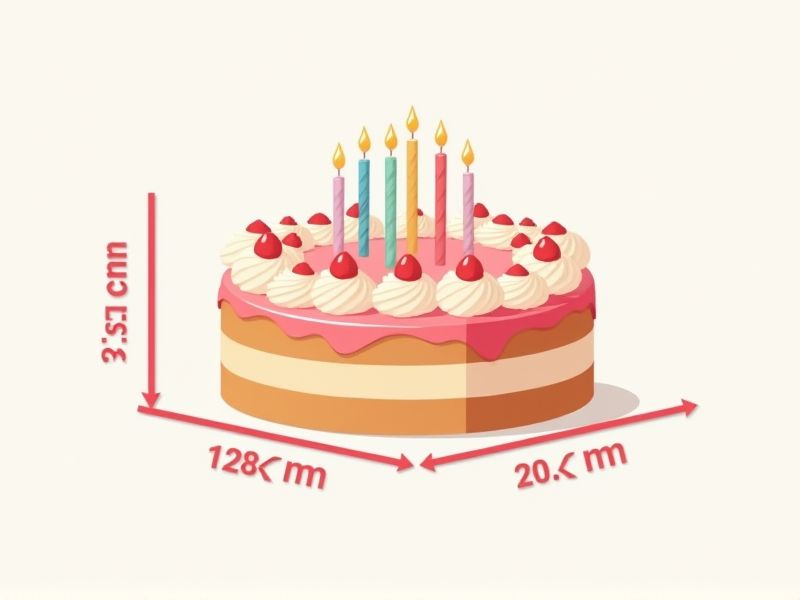
When planning a birthday cake, standard dimensions can be very helpful to ensure you have enough cake for your guests. A common round cake size is 8 inches in diameter, which typically serves 12-16 people, making it suitable for small celebrations. Sheet cakes, another popular option, are often 9x13 inches and can serve about 20-24 people depending on how generously you slice them. Knowing these typical sizes allows you to select the right cake for your gathering without over- or under-ordering.
Cake Size Options
When selecting a birthday cake, size options typically range from 6-inch to 12-inch cakes, accommodating various guest counts. A 6-inch cake generally serves 6 to 8 people, ideal for intimate celebrations or small gatherings. In contrast, a 10-inch cake can serve approximately 20 to 25 guests, making it suitable for mid-sized parties. For larger events, consider a 12-inch cake, which serves about 30 to 40 individuals, ensuring that all your guests enjoy a slice of the celebration.
Tier Dimensions
The standard dimensions for a tiered birthday cake typically range from 6 inches to 12 inches in diameter for each tier. A popular configuration includes a two-tier cake with a 6-inch top layer and an 8-inch bottom layer, serving approximately 20 to 30 guests. For larger gatherings, a three-tier cake can feature a 6-inch, 8-inch, and 10-inch arrangement, accommodating around 40 to 60 guests. When planning your cake, consider using at least 4 inches in height per tier for optimal design and decoration.
Height Standards
The ideal height for a standard birthday cake typically ranges from 4 to 6 inches tall. Cakes shorter than 4 inches may lack visual impact, while those above 6 inches can be challenging to cut and serve. For decorative purposes, tiered cakes often feature multiple layers, with each tier increasing height by 2 to 4 inches. When planning your cake, consider that a 6-inch cake serves approximately 12 to 14 people, making it a popular choice for small gatherings.
Serving Portions
A standard birthday cake typically serves 12 to 16 people, depending on the size and design. For a cake that is 8 inches in diameter, you can generally expect to serve around 12 slices, while a larger 10-inch cake can comfortably serve 16. When planning for your party, consider that each guest usually consumes about one slice, but this can vary based on factors like cake flavor and audience age. Therefore, if you're hosting a celebration with 20 guests, opting for a two-tier cake with specific portion planning may ensure everyone enjoys a piece without excess waste.
Diameter Measurements
The standard diameter for birthday cakes typically ranges from 6 to 12 inches, with the 8-inch cake being the most common choice for small gatherings. A 10-inch cake is ideal for celebrations with approximately 20 to 25 guests, while a 12-inch cake can serve around 30 to 40 people. For larger events, tiered cakes are often used, with each tier usually measuring 4 inches in height. Understanding these diameter measurements allows you to choose the perfect cake size to suit your guest count and occasion.
Shape Variability
The shape of a birthday cake can significantly influence its aesthetic appeal and overall experience, with common options including round, square, and heart-shaped designs. The round cake, typically favored for traditional celebrations, allows for even baking and easy slicing, while square cakes offer a modern touch with a unique presentation. Heart-shaped cakes are popular for romantic occasions, symbolizing love and affection, and often come in various sizes, from single-tier to multi-tiered creations. By selecting a cake shape that reflects the theme or personality of the celebration, you enhance both the visual impact and the delight of your event.
Layer Thickness
The standard thickness for each layer of a birthday cake typically ranges from 1 to 2 inches, ensuring a balanced ratio of cake to frosting. A well-constructed cake often includes at least three layers, resulting in an appealing height and the opportunity for multiple flavors. For a visually striking presentation, consider incorporating a filling like fruit preserves or cream between layers, enhancing taste and texture. Your choice of thickness impacts not only aesthetics but also the overall moistness and structural integrity of the cake, making it a key consideration in cake design.
Decoration Allowance
A standard birthday cake typically allocates 20-30% of its budget towards decoration, emphasizing visual appeal to enhance the celebratory atmosphere. Common decorative elements include frosting designs, edible images, and thematic accessories, each tailored to the recipient's interests or the party's theme. Consider intricate techniques like fondant draping or 3D decorations, which can elevate the cake's overall aesthetic. Investing in quality decorations can significantly impact your cake's impression, making it not only a delicious treat but also a centerpiece of the celebration.
Pan Sizes
When selecting a standard birthday cake, consider the pan sizes commonly used in baking, such as 8-inch, 9-inch, and 10-inch rounds. An 8-inch round cake typically serves about 12 people, while a 9-inch round size can accommodate around 20 servings. For larger gatherings, a 10-inch round cake, which serves approximately 30 guests, is an excellent choice. Understanding these dimensions helps you ensure that your cake meets your celebration's needs without surplus or shortage.
Weight Considerations
When selecting a birthday cake, weight is a crucial factor, as it typically influences both the size and number of servings. A standard-sized cake for 10 to 12 people usually weighs around 2 to 3 kg (4.4 to 6.6 lbs), ensuring adequate slices for guests. For larger gatherings, a multi-tiered cake may reach 5 kg (11 lbs) or more, with each tier adding significant weight and visual impact. It's vital to account for both the cake's weight and your guests' preferences to strike a balance between indulgence and practicality.
